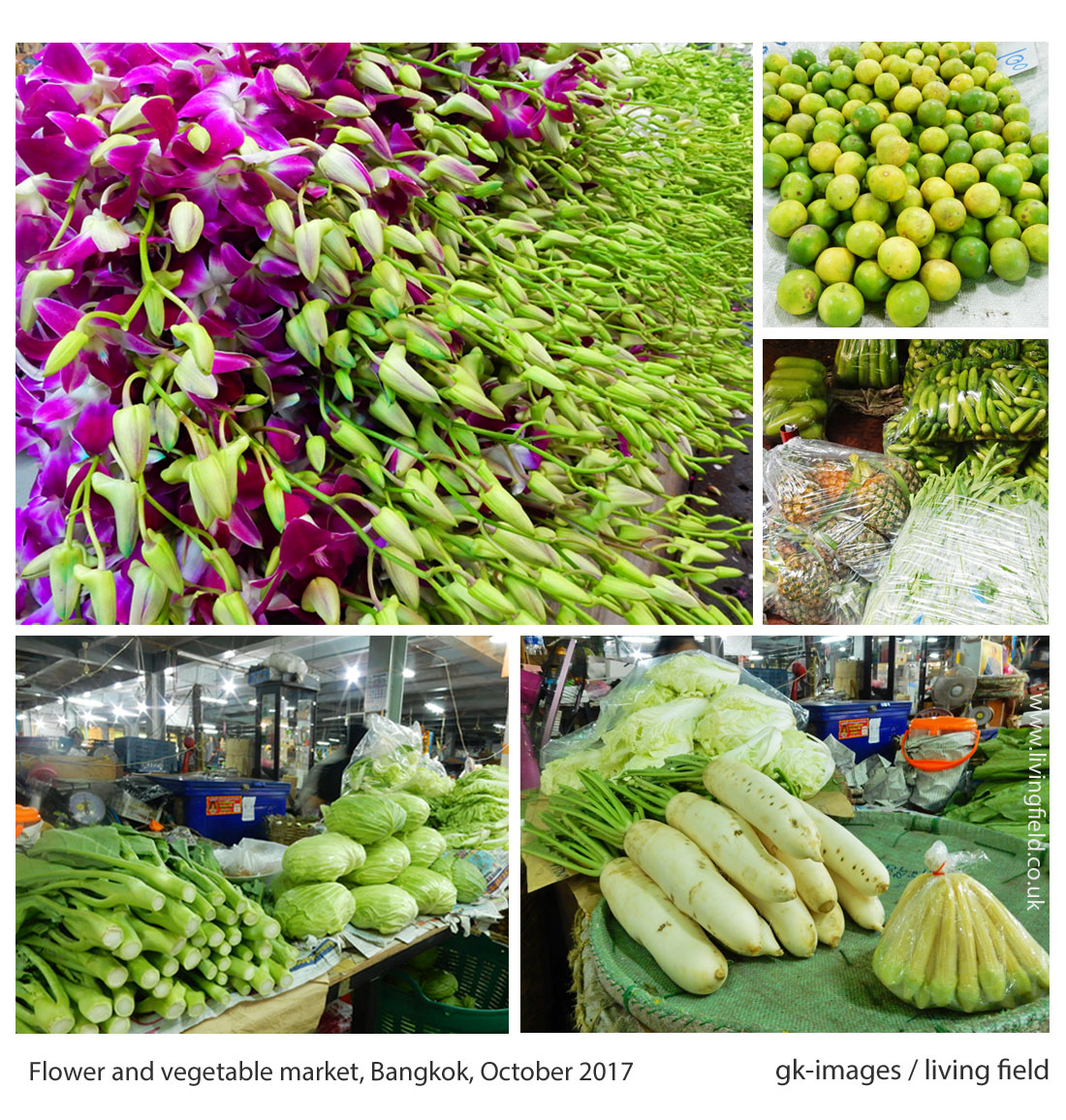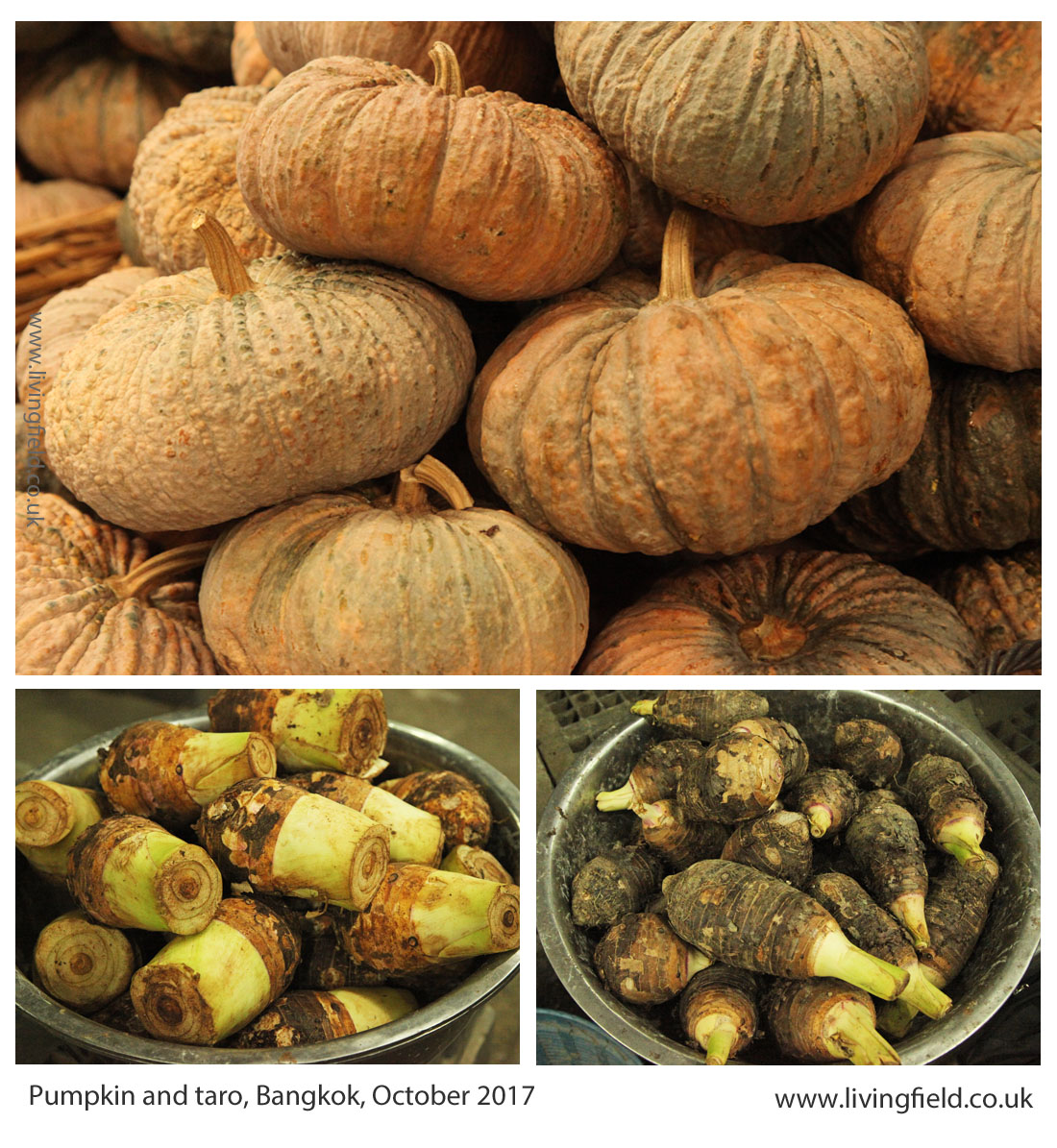When in south east Asia ….
…. the defining sights, textures and tastes of the region must include the vegetables and fruits that are on sale everywhere and form such a nutritious and tasteful part of the diet. The humblest stalls and open-air cafes offer such a range of fresh plant products, boiled or fried, alone or with with rice or noodles, as are rarely found in Europe. Take kangkong – steeped in garlic and soy sauce, a low-cost pure vegetable delight with no equivalent here [1].
Stalls everywhere sell pineapple, mango, lychee, papaya. In the season, durians and mangosteens, rambutans, custard apples and jack fruit offer unique tastes and textures [2].
So a visit to the vegetable and fruit markets of Bangkok was not to be missed.
 The main flower market sells fresh flowers, fruits and vegetables. Above are a great bank of flowering orchids, for show, not to eat, limes (? top right), pineapples and courgettes, roots including very large ‘radishes’, and leaf vegetables.
The main flower market sells fresh flowers, fruits and vegetables. Above are a great bank of flowering orchids, for show, not to eat, limes (? top right), pineapples and courgettes, roots including very large ‘radishes’, and leaf vegetables.
Most produce was bagged, or in the process of being, and taken away on bicycles, scooters and tuk-tuks, most likely on short supply chains to hotels, restaurants and cafes in the city. The bikes and scooters politely elbowed and wheeled their way through people.
 No small packets here – but great quantities of things: six-feet high banks of lemon grass (top left above), then ginger, chillies and spiny gourds.
No small packets here – but great quantities of things: six-feet high banks of lemon grass (top left above), then ginger, chillies and spiny gourds.
In Europe we are used to seeing and eating the yellow-skinned banana fruits. But here also the banana’s unopened flowering heads were for sale [3], destined for gourmet cook-shops.
The produce covered the wide range of storage times found at good markets anywhere [4]. Everything from leafy greens and herbs, high in vitamins and minerals, needing to be cooked and eaten within days before they go off, contrasting with the roots and tubers which, like our potato and swede, can last for weeks, months even, sustaining people and animals over bad times. Of the longer lasting vegetables were taro [5] and various sorts of pumpkin.
It was a busy place: many small traders, most everything visible. Food in, food out, quickly. Another world from the big retailers that most Europeans buy from.
Notes, links
[1] Kangkong or kangkung – is one of the simplest of dishes, made from the leafy shoots of various plants, the most common being Ipomoea aquatica. Laced with garlic, mild chillies and soy sauce, a culinary delight, served at the humblest of roadside cook shops.
[2] Of these fruits, the Durian, is the king, they say. It’s of the genus Durio, of which there are many species. There’s little point in a European trying to describe a durian. They have to be experienced. But don’t just try any one that you come across. Durian experts say – select not the first of the season, and not the northernmost, but bide your time, smell each one discerningly, and lingeringly … and blessings will be yours. A bit arcane, this durian lore – but from experience, it seems to work. And they do say that people go to extremes over the best wild durians, keeping them under guard night and day while fruiting, until they are just right. Also the other fruits mentioned may be palate-changing – mangosteens and custard apples, for example – and don’t be put off by the outer appearance of the jackfruit, because inside it’s ….. delicious.
[3] The fruits of the plantation banana are well known here, but the large flower buds and flowers of assorted plantains including the commercial banana (all Musa species) are widely used in cooking in south-east Asia.
[4] Links on this web site to vegetable markets include 2 Veg to Pellagra (Carcassonne and Burma) and Inle Lake Burma.
[5] Taro Colocasia esculenta is not so appreciated in Europe, but is a staple of village subsistence throughout south-east Asia. It is close taxonomically to Arum maculatum, the lords and ladies of the cropland’s hedges and shady corners. For more on taro intercropped with ginger and chillies in Burma (Myanmar), see Mixed Cropping in Burma at curvedflatlands. Note the Latin name esculenta has been used for centuries in Scotland – in the form ‘esculent’ – to refer to tuber crops, including potato. For reference and source, see SoScotchBonnet on this web site.
Notes and experiences by geoff.squire@hutton.ac.uk
Thanks to gk-images for the photographs in the first two panels above.
Links to other pages and posts on vegetables on this site:
- Transition Turriefield – vegetable production in Shetland.
- Can we grow more vegetables? – the vegetable map of Scotland.
- Vegetables in the Living Field garden: Garden/vegetables and the Garden’s vegetable bounty.



